
It's the end of the week and the end of the month, so we will be "Wrapping" about not only weekly charts, but monthly charts as well. Many have noted that the Long-Term Price Momentum Oscillator (PMO) signal on the Dow Industrials has been on a "SELL" signal since 2018; whereas, the SPX, OEX and NDX have all had monthly PMO BUY signals with monthly PMOs still rising. We will discuss the SPY monthly chart in a moment, but take a look at the monthly PMO on the Dow. Not only is it still on a 2018 SELL signal, it has now topped below its signal line. PMO tops below the signal line can be considered especially bearish.
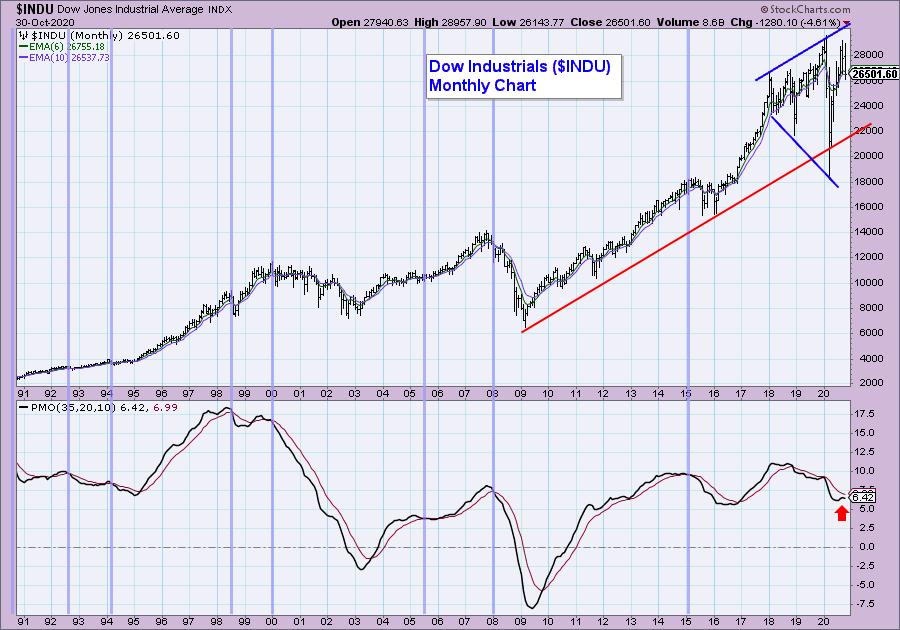
The DecisionPoint Alert Weekly Wrap presents an end-of-week assessment of the trend and condition of the Stock Market, the U.S. Dollar, Gold, Crude Oil, and Bonds. The DecisionPoint Alert daily report (Monday through Thursday) is abbreviated and gives updates on the Weekly Wrap assessments.
Watch the latest episode of DecisionPoint on StockCharts TV's YouTube channel here!
MAJOR MARKET INDEXES
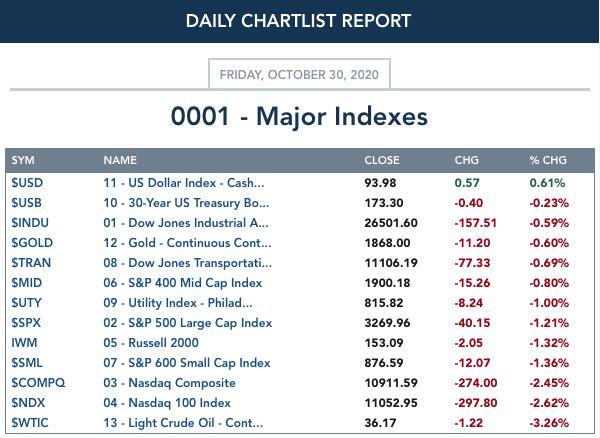
SECTORS
Each S&P 500 Index component stock is assigned to one, and only one, of 11 major sectors. This is a snapshot of the Intermediate-Term (Silver Cross) and Long-Term (Golden Cross) Trend Model signal status for those sectors.
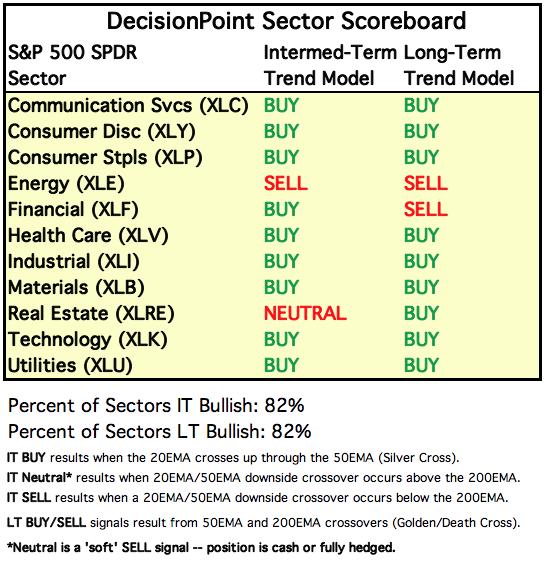
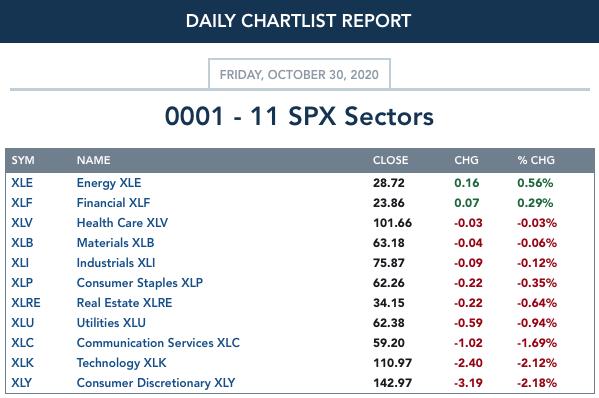
THE MARKET (S&P 500)
IT Trend Model: BUY as of 5/8/2020
LT Trend Model: BUY as of 6/8/2020
SPY Daily Chart: The SPY has accelerated its declining trend. Support at $320 will need to hold. That is the confirmation line for the large double-top formation. The PMO has managed to stay above zero, but that should change next week. The RSI is negative. Notice the pop in volume today on this 1%+ decline. The VIX continues to puncture the lower Bollinger Band on the inverted scale. This is a very short-term oversold condition, but in a bearish environment, it doesn't necessarily lead to a strong rally. The early September VIX punctures only amounted to a pause in the overall decline that culminated in a mid-September bottom.
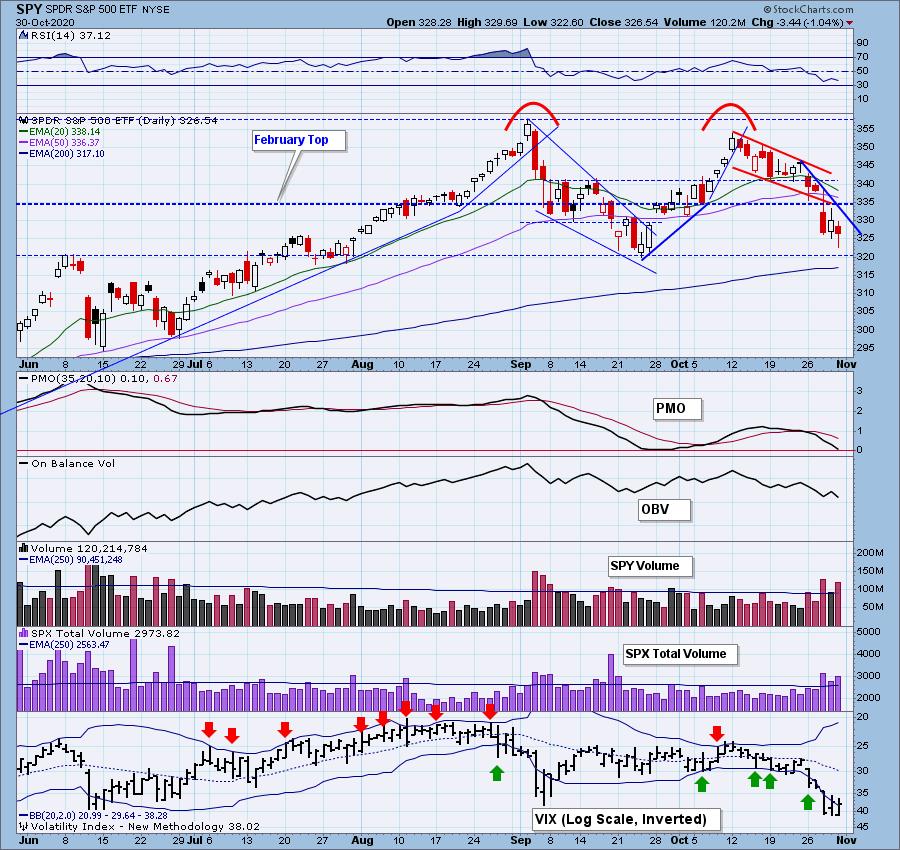
The double-top is the dominant feature on the 1-year OHLC daily chart. The 200-EMA coincides with the confirmation line. That offers strong support, but if it fails, the minimum downside target is $280 based on the height of the double-top.
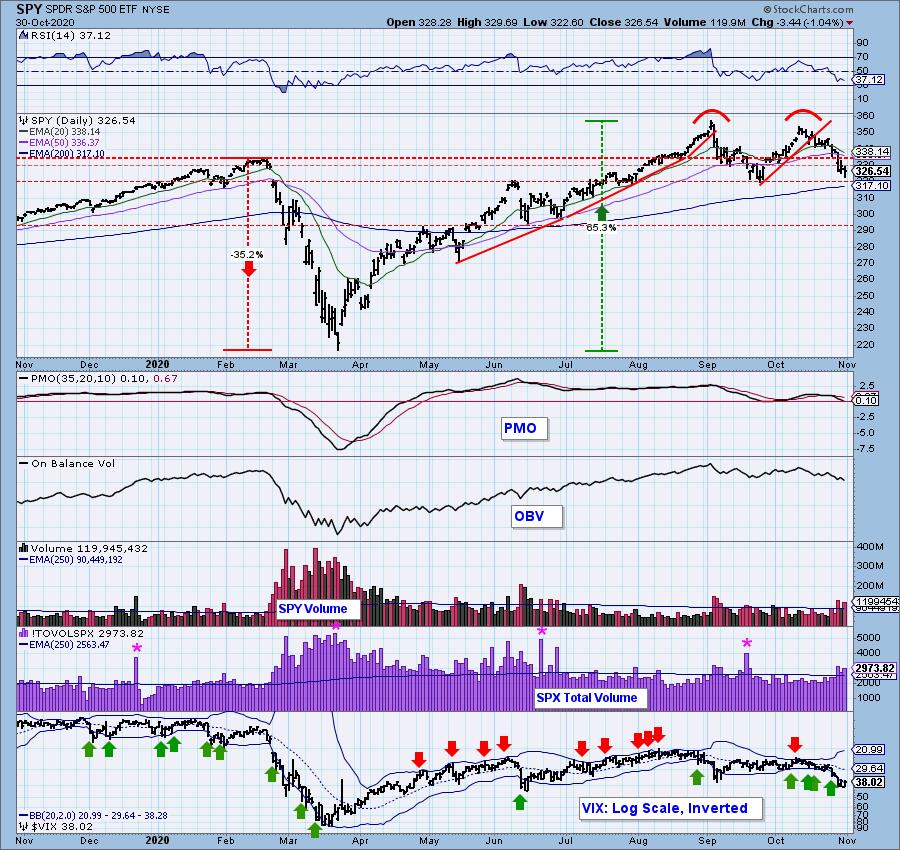
SPY Weekly Chart: Broadening patterns or "megaphones" accentuate the volatility in the market. This double-top is forming right at the top of this megaphone.
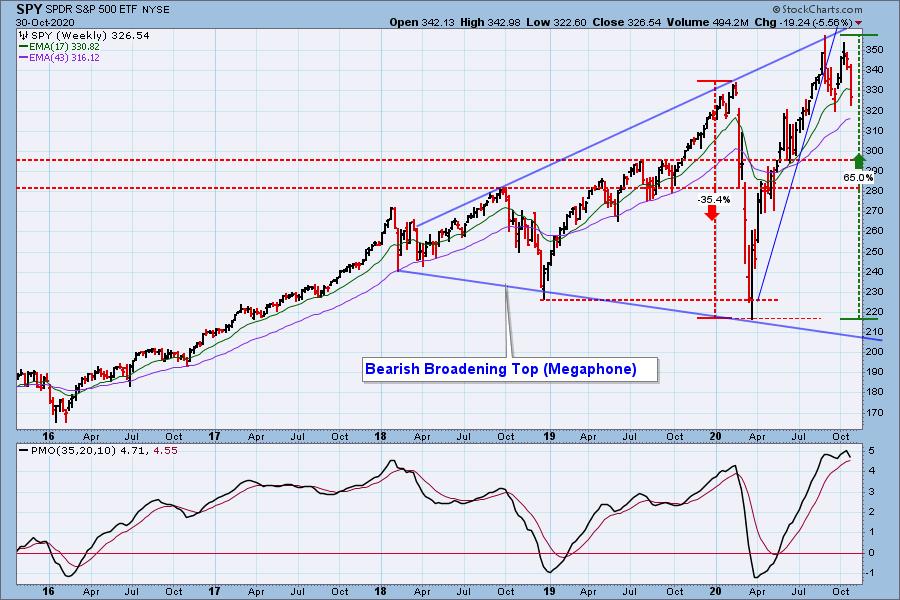
S&P 500 Monthly Chart: The secular bull market rising trend has not yet been broken. The 12-month EMA is holding up so far.
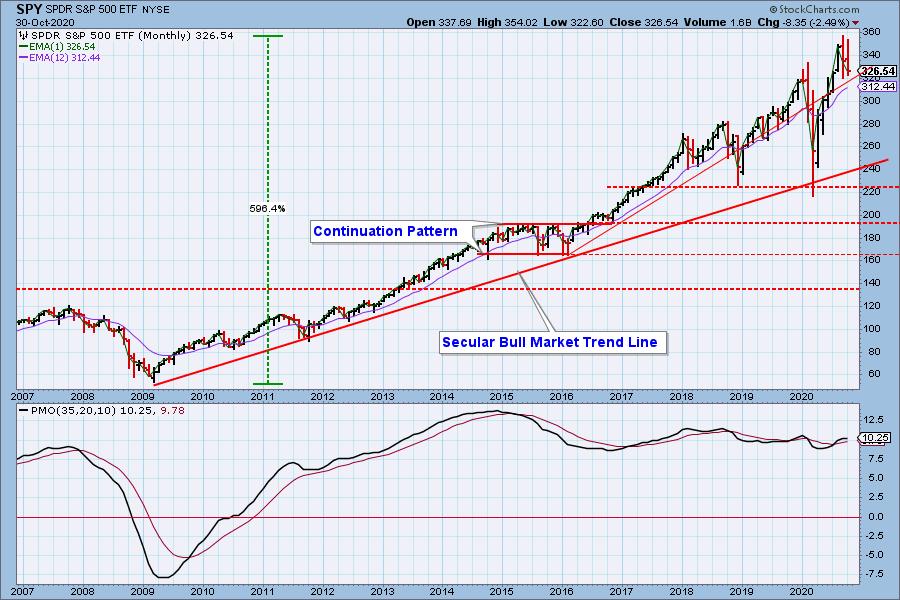
Participation: The following chart uses different methodologies for objectively showing the depth and trend of participation for intermediate- and long-term time frames.
- The Silver Cross Index (SCI) shows the percentage of SPX stocks on IT Trend Model BUY signals (20-EMA > 50-EMA).
- The Golden Cross Index (GCI) shows the percentage of SPX stocks on LT Trend Model BUY signals (50-EMA > 200-EMA).
- The Bullish Percent Index (BPI) shows the percentage of SPX stocks on Point & Figure BUY signals.
We've been watching these indicators decline all week. One could argue that the SCI and BPI are near-term oversold; however, if this turns into a bear market, these indicators are from oversold.
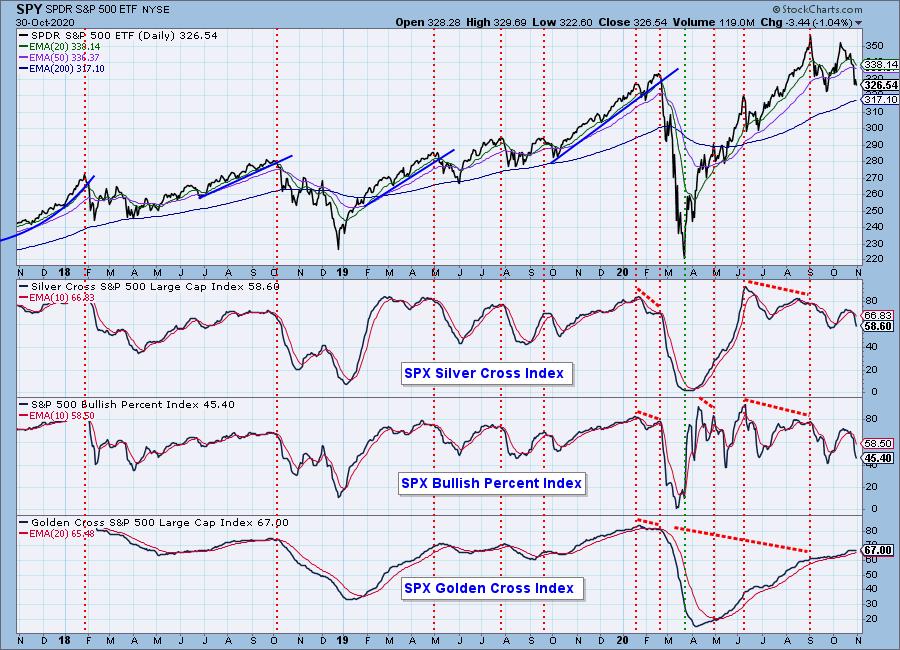
The %Stocks > 20/50-EMAs indicators are oversold, but again, those conditions can persist when we have a bearish bias. March is an excellent example.
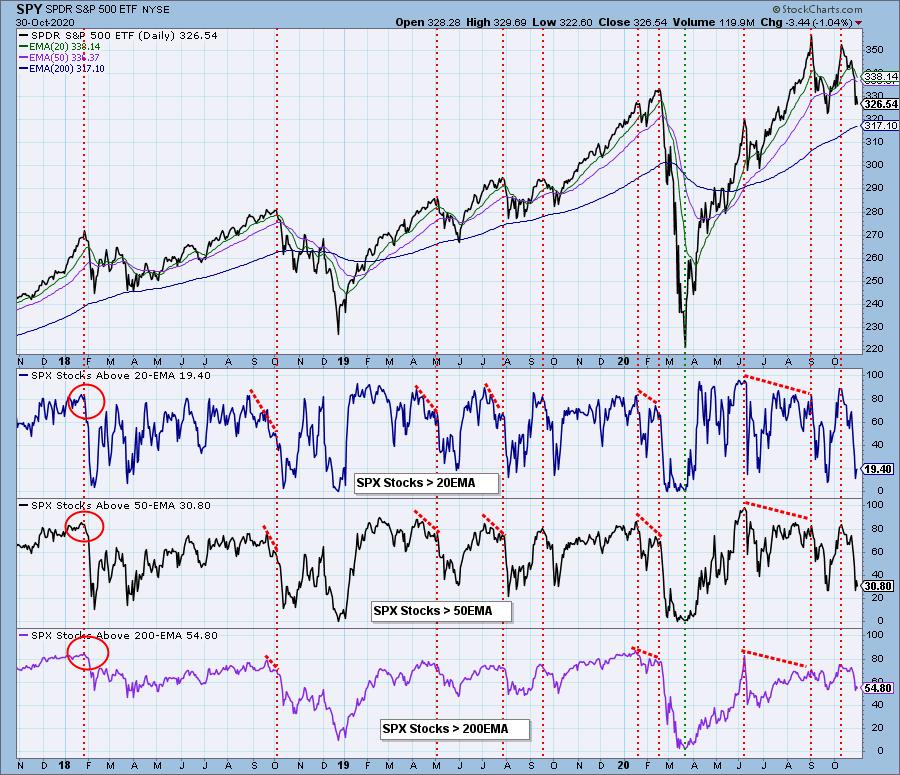
Climactic Market Indicators: No climactic readings today, but we did experience some climaxes this week which turned out to be related to a selling exhaustion. Relief came in the form of a rally on Thursday, but that was all she wrote.
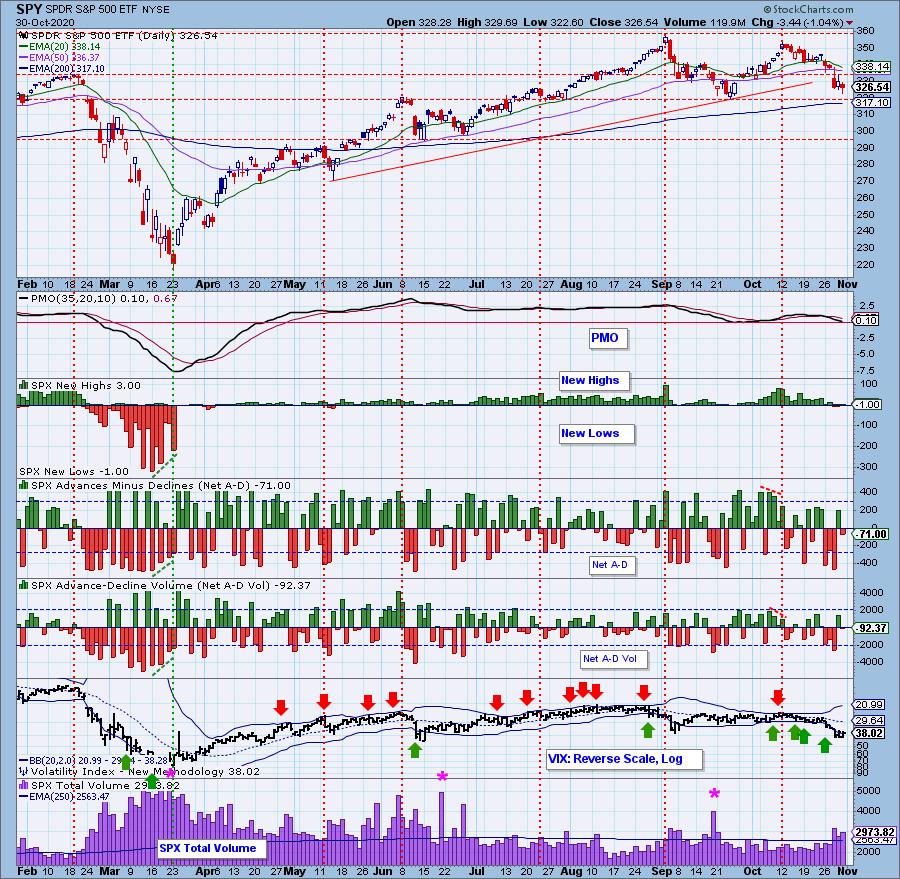
NYSE Up/Down and Down/Up volume ratios can be also be used as climax detectors. We use the 9:1 ratio suggested by the late Dr. Martin Zweig in his book, Winning on Wall Street. These climaxes happen less frequently than those on the chart above, and they can be used to clarify a particular event. We have an NYSE and S&P 500 version of the ratios, and normally they will only be published when there is a climax ratio.
There were no Up/Down climaxes in the time period shown, but there were three downside exhaustion climaxes on the Down/Up (bottom) panel, two of which confirmed the climactic indicators on the chart above this week.
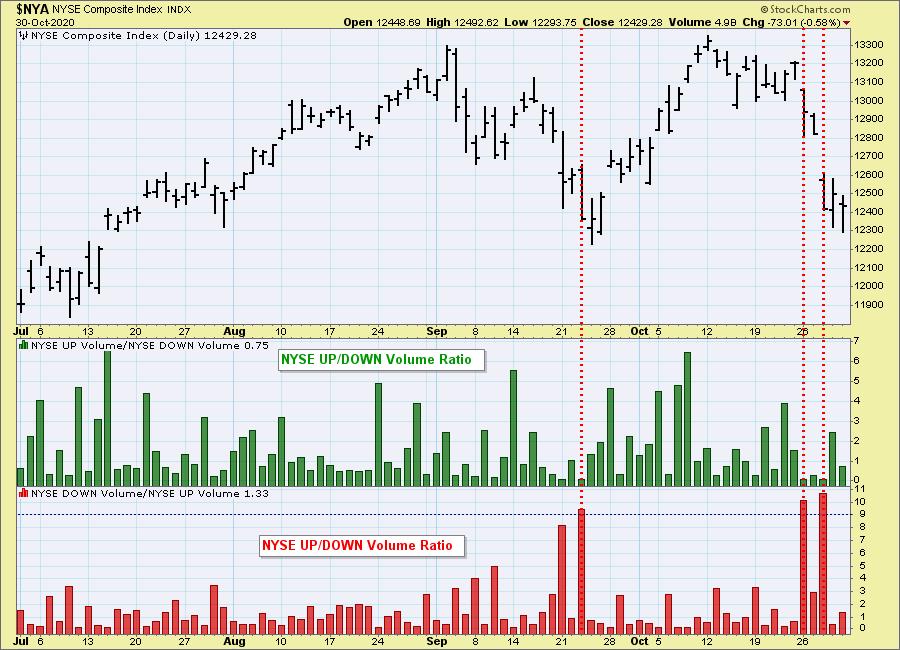
The S&P 500 version can get different results than the NYSE version because: (a) there are only 500 stocks versus a few thousand; and (b) those 500 stocks are all large-cap stocks that tend to move with more uniformity. Notice that there were two upside initiation climaxes, and two downside exhaustion climaxes on this chart.
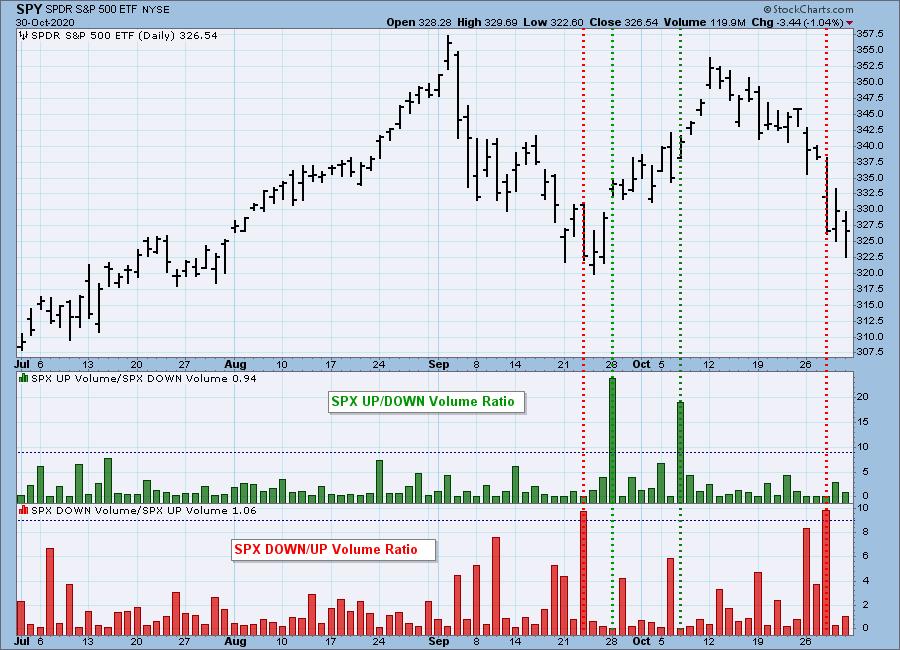
Short-Term Market Indicators: The short-term market trend is DOWN and the condition is OVERSOLD. These indicators are oversold. We certainly saw more negative readings in March and if we are in for a large correction, those indicators can stretch further into oversold territory. %Stocks indicators are oversold.
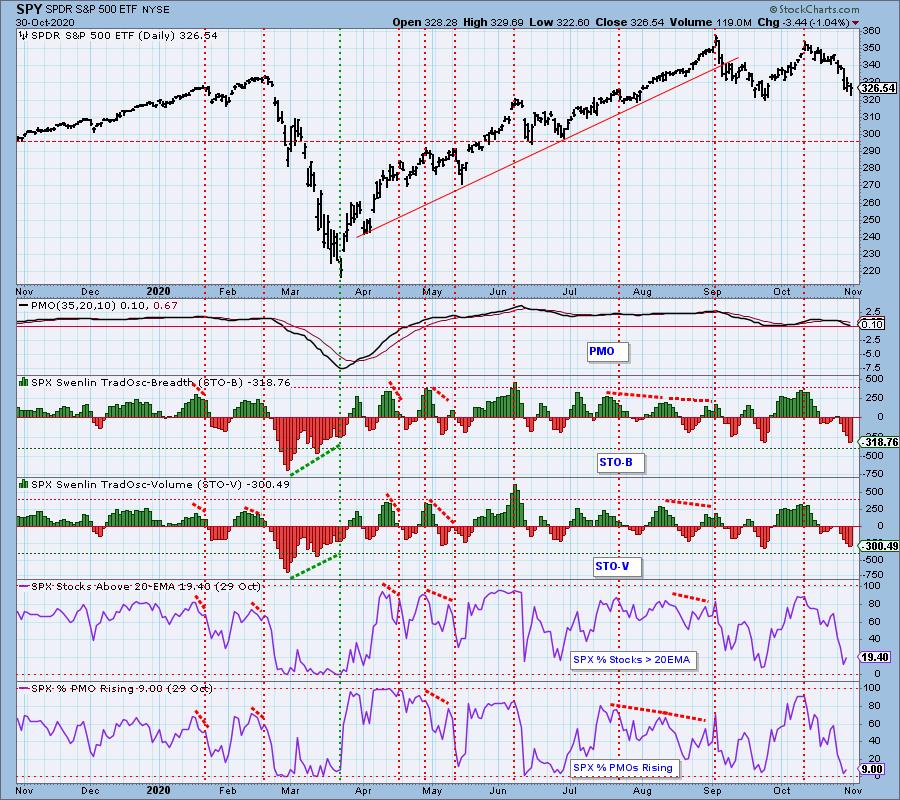
Intermediate-Term Market Indicators: The intermediate-term market trend is UP and the condition is NEUTRAL. The market bias is NEUTRAL. These indicators continue to decline. They haven't reached negative territory yet and therefore could accommodate a fulfillment of the double-top pattern.
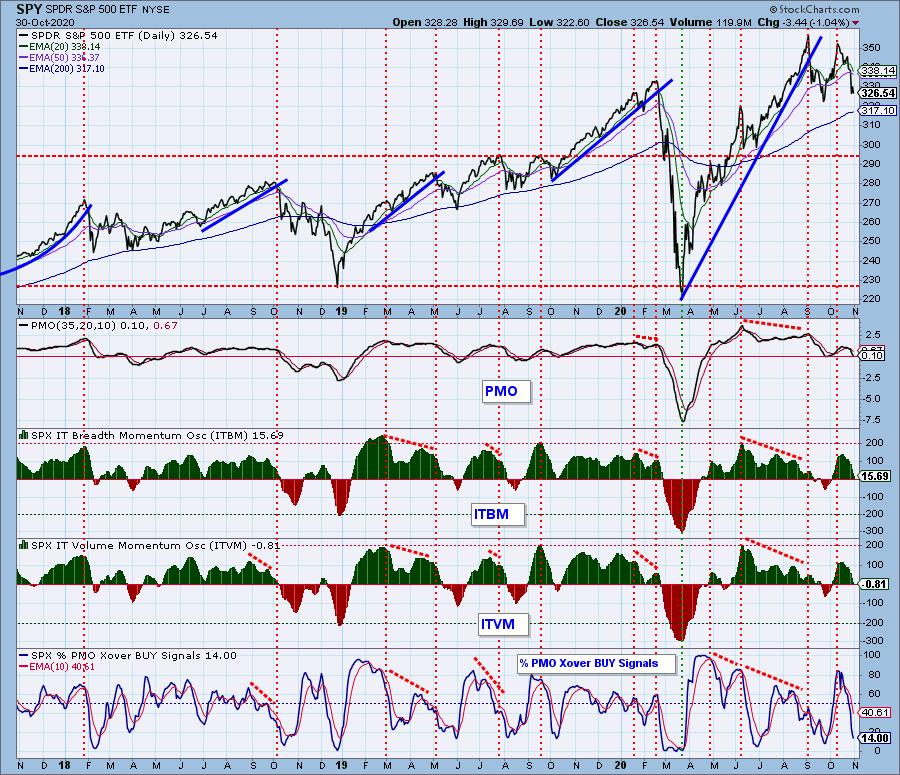
CONCLUSION: The large double-top looms on the SPY and other major index charts. We arriving at the confirmation line. Short-term indicators are mostly oversold so a short-term bounce would be welcome. However, the intermediate-term indicators are far from oversold. We may not experience rough waters, but best to prepare by battening down the hatches.
NOTE: Six-month seasonality becomes favorable next week, and will extend to May 1, 2021. That doesn't mean that our glasses will become rose-colored, just that seasonality issues will be working in our favor. Sometimes, and this is probably one of those times, there are far more powerful issues that are working against positive market outcomes, so we take seasonality with a grain of salt.
Have you subscribed the DecisionPoint Diamonds yet? DP does the work for you by providing handpicked stocks/ETFs from exclusive DP scans! Add it with a discount! Contact support@decisionpoint.com for more information!
INTEREST RATES
This chart is included so we can monitor rate inversions. In normal circumstances the longer money is borrowed the higher the interest rate that must be paid. When rates are inverted, the reverse is true.
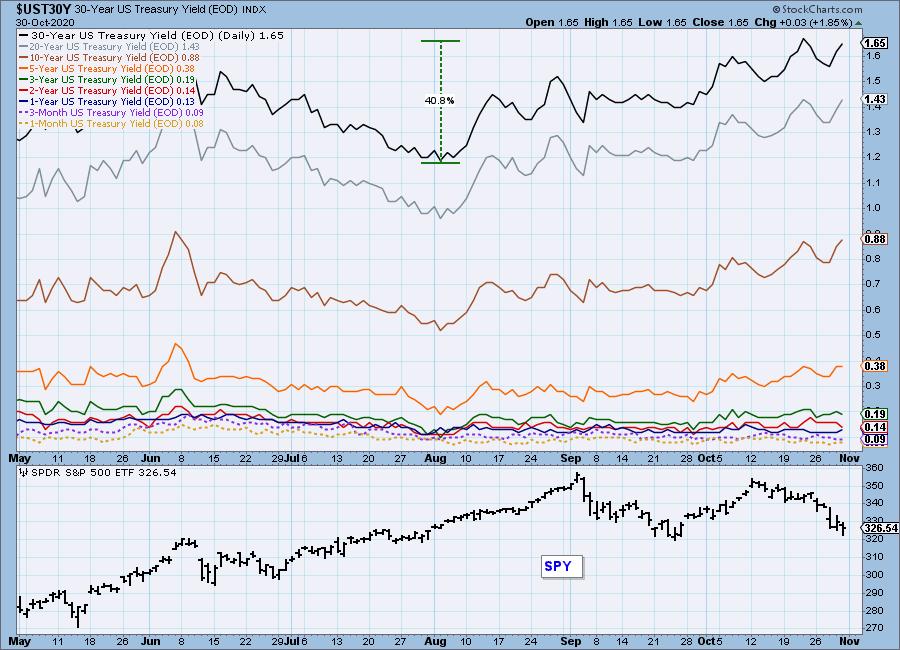
DOLLAR (UUP)
IT Trend Model: NEUTRAL as of 5/28/2020
LT Trend Model: SELL as of 7/10/2020
UUP Daily Chart: We could be seeing a double-bottom pattern forming. The RSI is positive and the PMO has triggered a BUY signal this week. We do need to temper our bullish expectations given the bearish configuration of the 20/50/200-EMAs.
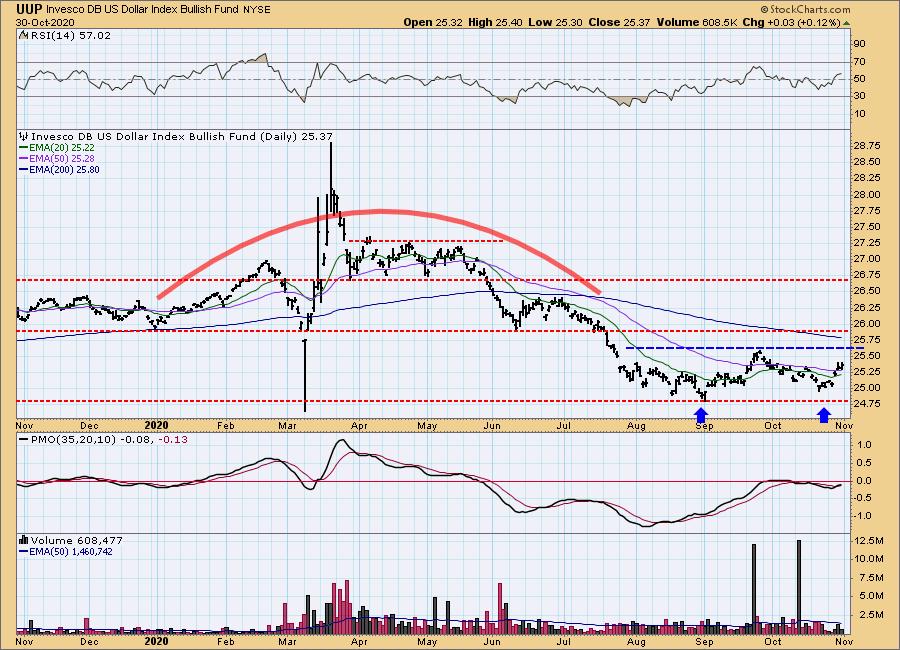
UUP Weekly Chart: The double-bottom is more clear on the weekly chart. The PMO is turning up and the RSI is rising, albeit negative. Overhead resistance is at the 2017 top around $26.
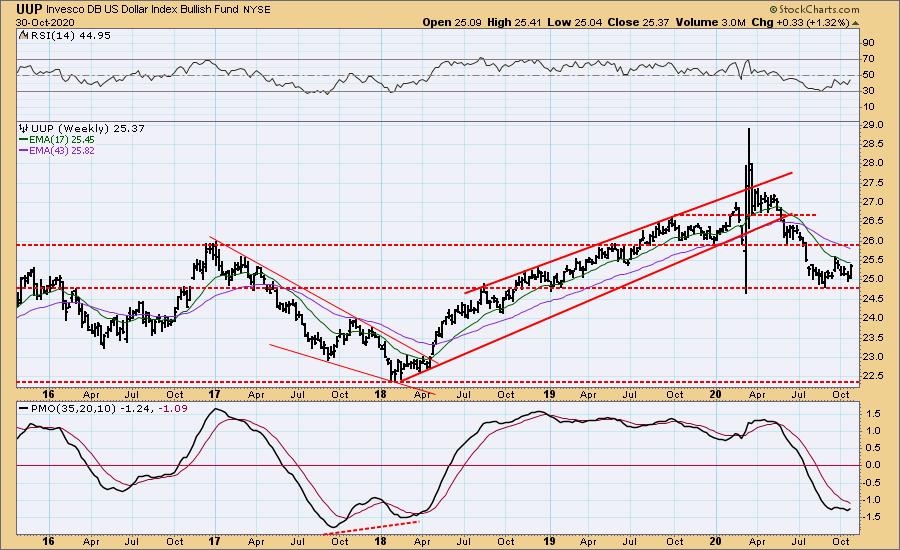
UUP Monthly Chart: The monthly PMO is very negative.
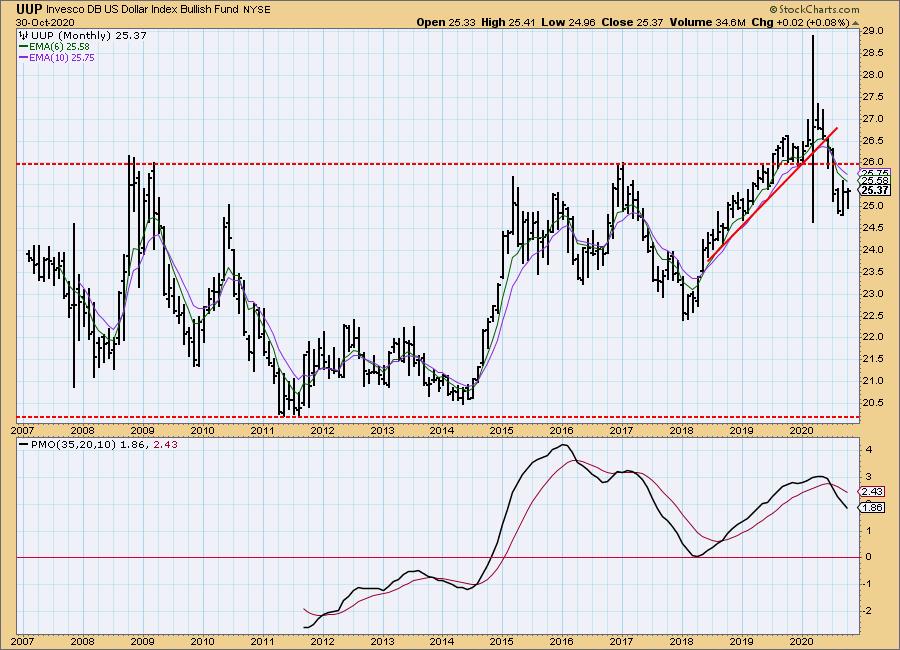
GOLD
IT Trend Model: NEUTRAL as of 10/23/2020
LT Trend Model: BUY as of 1/8/2019
GOLD Daily Chart: The bullish falling wedge is still dominating the daily chart. The PMO is attempting to decelerate and turn, but it appears price is headed to test the bottom of the wedge.
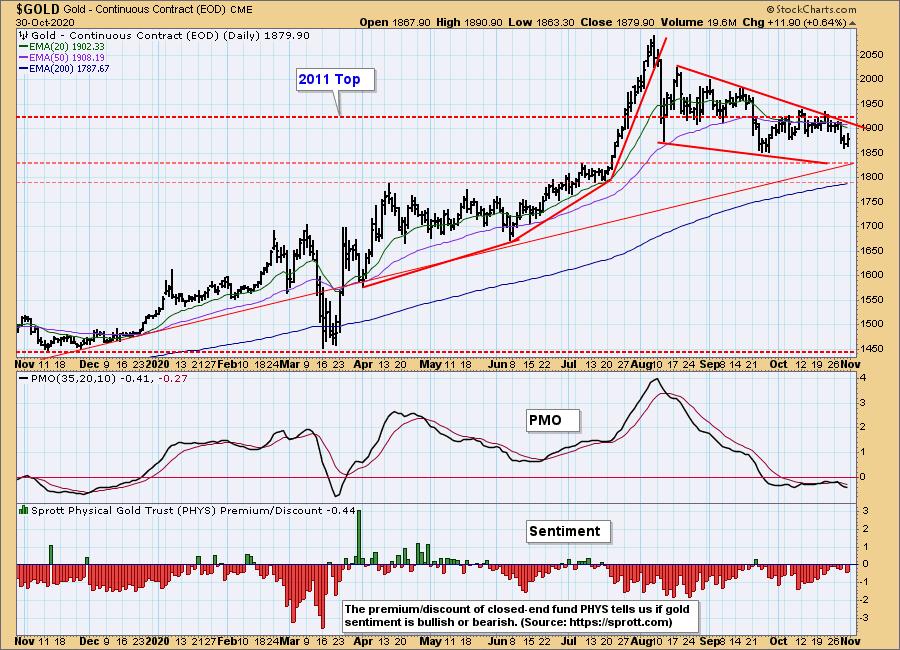
GOLD Weekly Chart: The weekly chart shows a PMO SELL signal. This week we ended up seeing a premium on PHYS which suggests that gold buyers are more interested. Remember sentiment is contrarian so bullish participants is considered bearish for price.
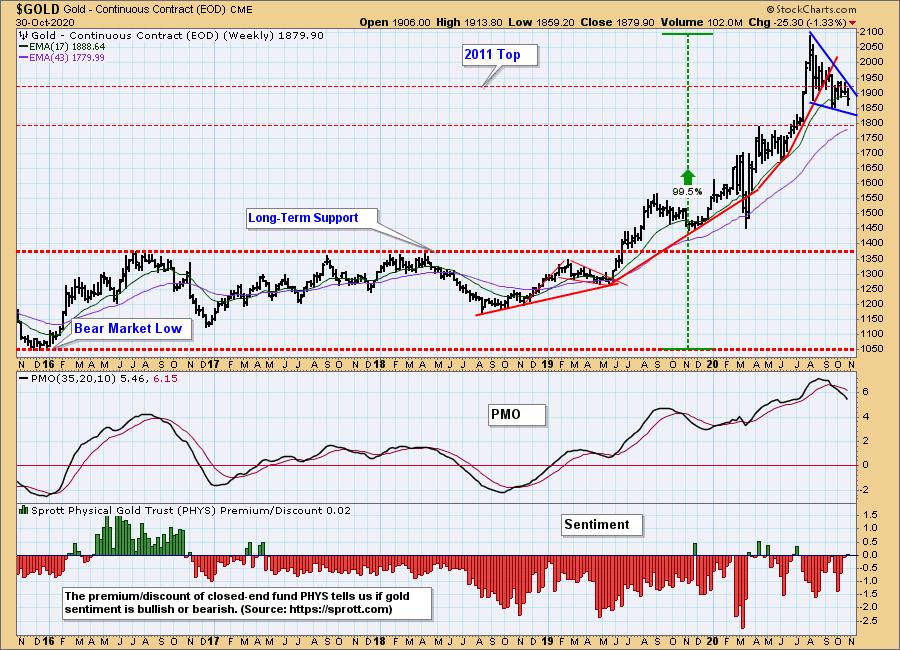
GOLD Monthly Chart: Gold has been on a parabolic run. However, the PMO is not overbought. The reverse correlation with the Dollar is increasing. Remember the Dollar is looking bullish and a strong reverse correlation with the Dollar means downward pressure on Gold.
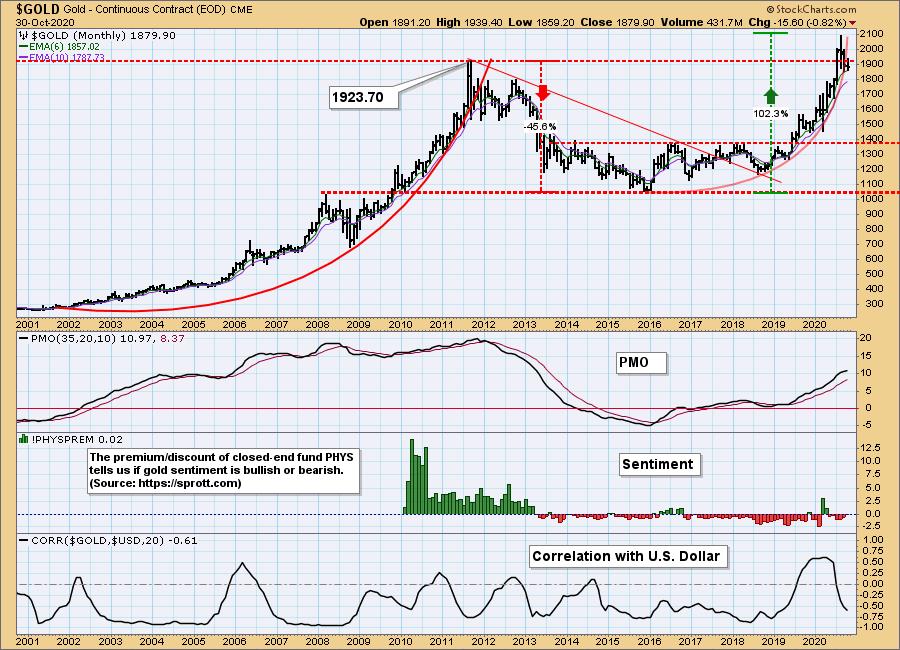
GOLD MINERS Golden and Silver Cross Indexes: So far Miners are holding the 200-EMA as support. Unfortunately they haven't broken back into the prior trading range. The PMO is falling and negative. The RSI is negative. What is positive is a BPI that has flattened and very oversold readings on %Stocks > 20/50-EMA.
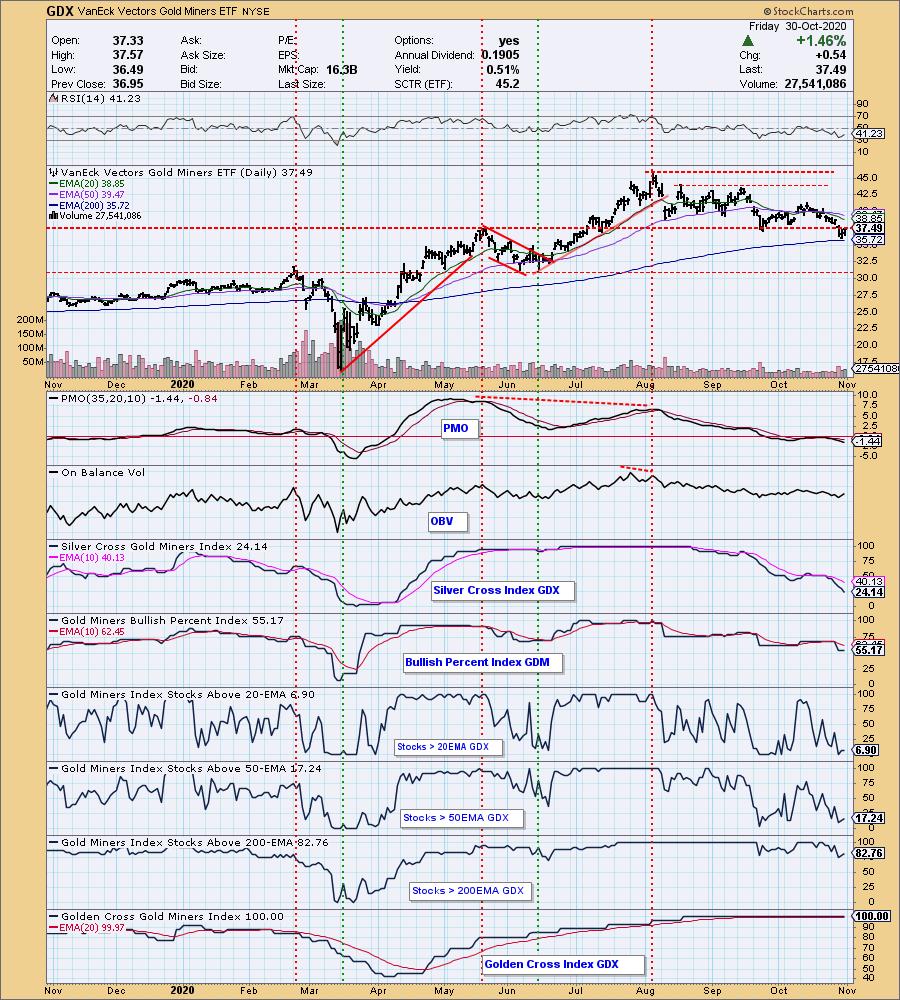
CRUDE OIL (USO)
IT Trend Model: SELL as of 9/8/2020
LT Trend Model: SELL as of 2/3/2020
USO Daily Chart: Oil has now dropped out of the summer trading range and is back to testing the late May low $24. We aren't expecting much from Oil until demand increases.

USO/$WTIC Weekly Chart: The weekly PMO is technically rising, but we can see $WTIC hitting overhead resistance and turning lower.
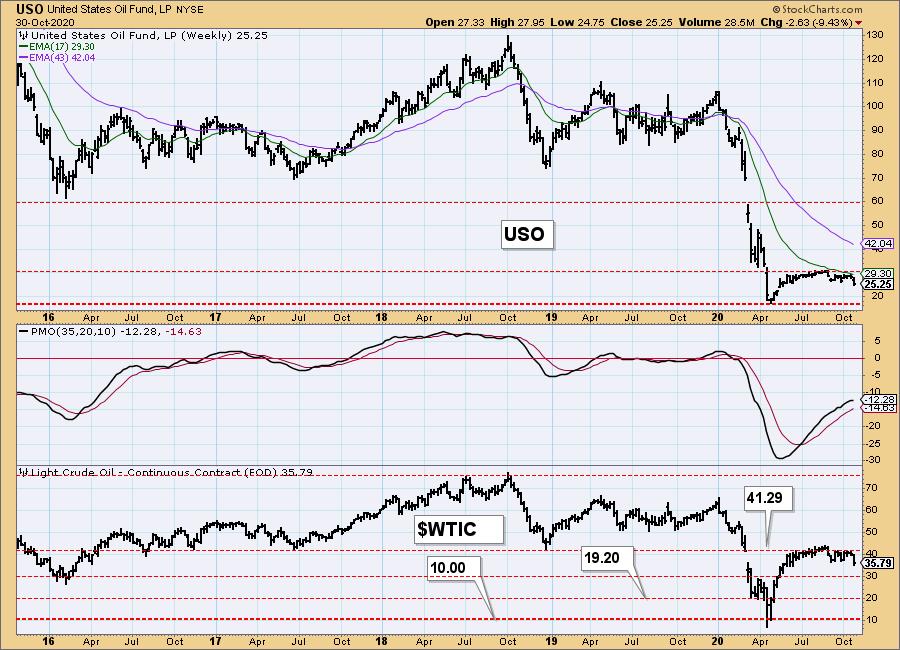
$WTIC Monthly Chart: The monthly PMO is rising but decelerating a bit as price digests the rally out of the bear market low.
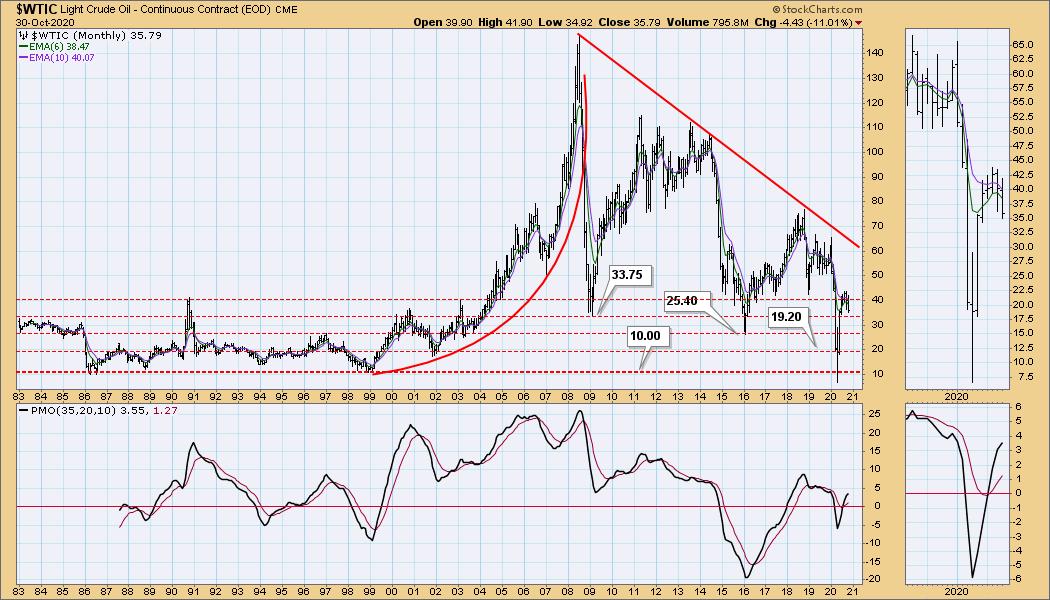
BONDS (TLT)
IT Trend Model: NEUTRAL as of 8/27/2020
LT Trend Model: BUY as of 1/2/2019
TLT Daily Chart: TLT declined heavily again today and has closed below the 200-EMA on its low for the day. The PMO topped below the signal line which is especially bearish. As yields rise we will continue to see Bond prices weaken.
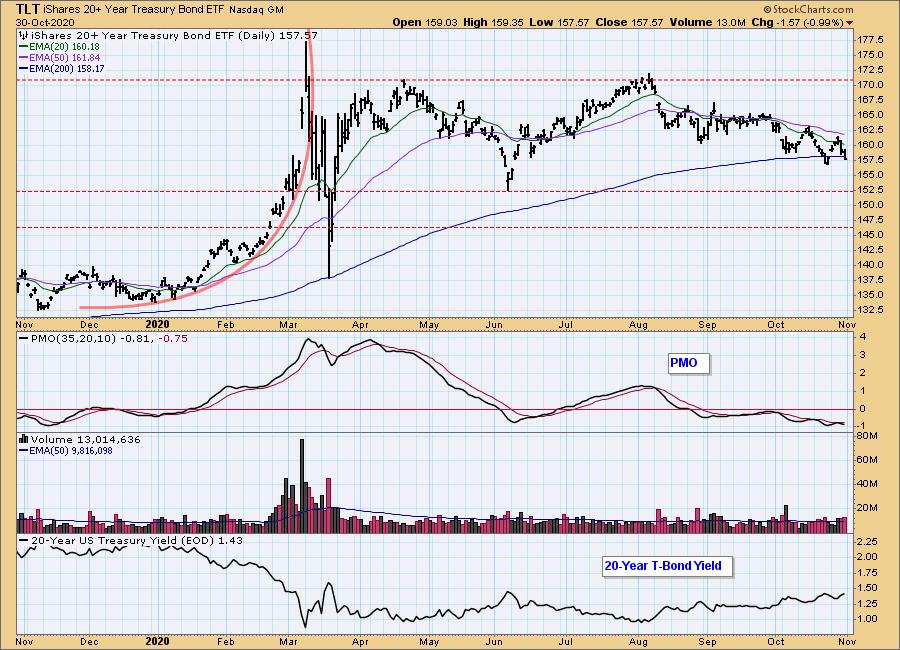
TLT Weekly Chart: The weekly PMO is falling and showing no deceleration. The 43-week EMA is holding up so far, but it appears price is headed to test the June low.
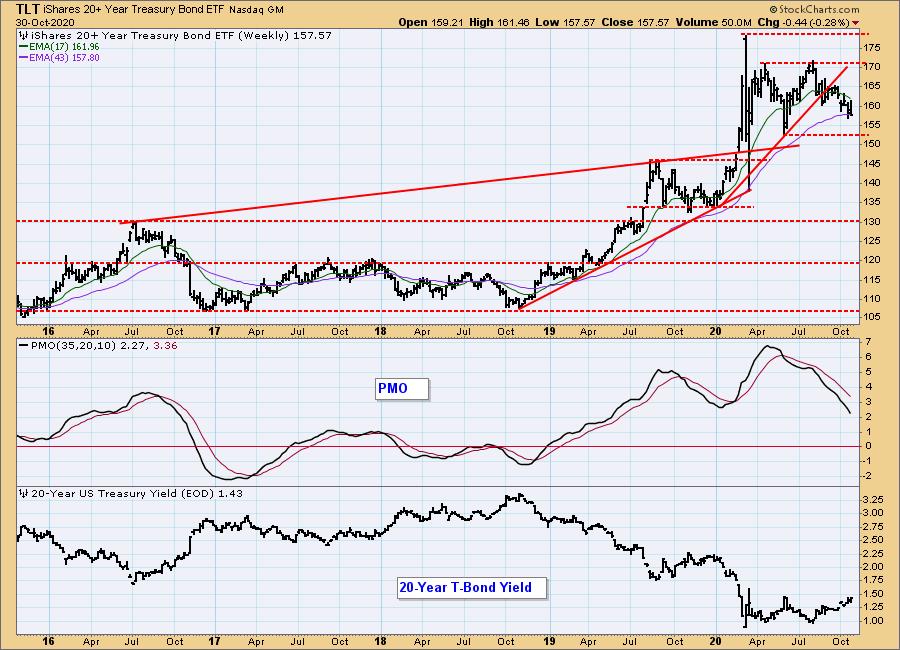
TLT Monthly Chart: The monthly PMO is topping. The parabolic pattern is breaking down and a bearish double-top is forming.
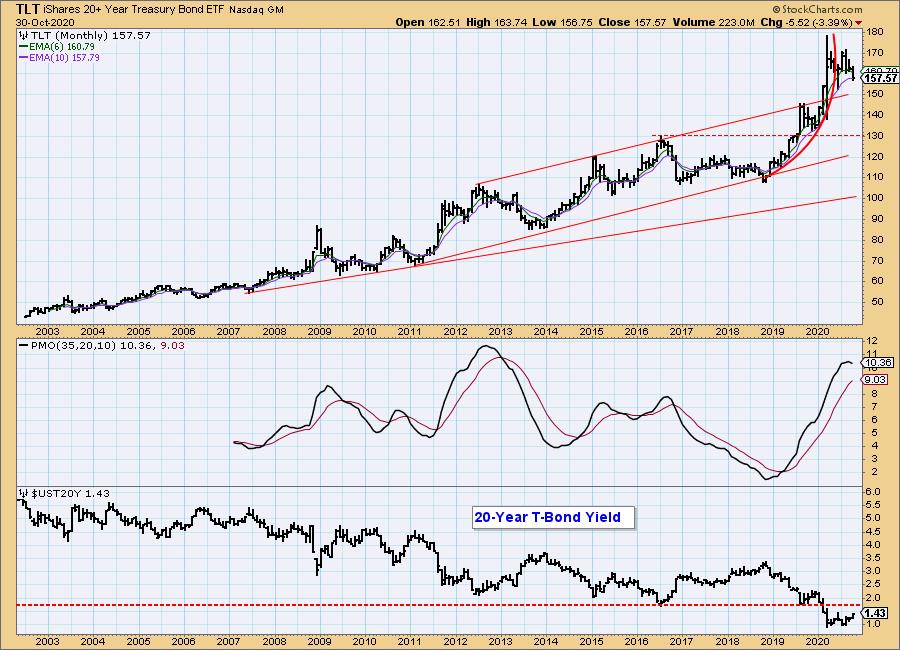
Technical Analysis is a windsock, not a crystal ball.
-- Carl & Erin Swenlin
___________
Our job is not to see the future, it is to see the present very clearly.
-- Jawad Mian, stray-reflections.com
Disclaimer: This blog is for educational purposes only and should not be construed as financial advice. The ideas and strategies should never be used without first assessing your own personal and financial situation, or without consulting a financial professional. Any opinions expressed herein are solely those of the author, and do not in any way represent the views or opinions of any other person or entity.
NOTE: The signal status reported herein is based upon mechanical trading model signals, specifically, the DecisionPoint Trend Model. They define the implied bias of the price index based upon moving average relationships, but they do not necessarily call for a specific action. They are information flags that should prompt chart review. Further, they do not call for continuous buying or selling during the life of the signal. For example, a BUY signal will probably (but not necessarily) return the best results if action is taken soon after the signal is generated. Additional opportunities for buying may be found as price zigzags higher, but the trader must look for optimum entry points. Conversely, exit points to preserve gains (or minimize losses) may be evident before the model mechanically closes the signal.
Helpful DecisionPoint Links:
DecisionPoint Alert Chart List
DecisionPoint Golden Cross/Silver Cross Index Chart List
DecisionPoint Sector Chart List
Price Momentum Oscillator (PMO)
Swenlin Trading Oscillators (STO-B and STO-V)
